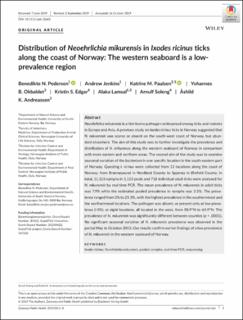| dc.contributor.author | Pedersen, Benedikte Nevjen | |
| dc.contributor.author | Jenkins, Andrew | |
| dc.contributor.author | Paulsen, Katrine Mørk | |
| dc.contributor.author | Yohanns B, Okbaldet | |
| dc.contributor.author | Edgar, Kristin Skarsfjord | |
| dc.contributor.author | Lamsal, Alaka | |
| dc.contributor.author | Soleng, Arnulf | |
| dc.contributor.author | Andreassen, Åshild Kristine | |
| dc.date.accessioned | 2020-07-09T09:55:23Z | |
| dc.date.available | 2020-07-09T09:55:23Z | |
| dc.date.created | 2019-12-19T13:47:50Z | |
| dc.date.issued | 2019 | |
| dc.identifier.citation | Zoonoses and Public Health. 2019, | en_US |
| dc.identifier.issn | 1863-1959 | |
| dc.identifier.uri | https://hdl.handle.net/11250/2661588 | |
| dc.description.abstract | Neoehrlichia mikurensis is a tick‐borne pathogen widespread among ticks and rodents in Europe and Asia. A previous study on Ixodes ricinus ticks in Norway suggested that N. mikurensis was scarce or absent on the south‐west coast of Norway, but abundant elsewhere. The aim of this study was to further investigate the prevalence and distribution of N. mikurensis along the western seaboard of Norway in comparison with more eastern and northern areas. The second aim of the study was to examine seasonal variation of the bacterium in one specific location in the south‐eastern part of Norway. Questing I. ricinus were collected from 13 locations along the coast of Norway, from Brønnøysund in Nordland County to Spjærøy in Østfold County. In total, 11,113 nymphs in 1,113 pools and 718 individual adult ticks were analysed for N. mikurensis by real‐time PCR. The mean prevalence of N. mikurensis in adult ticks was 7.9% while the estimated pooled prevalence in nymphs was 3.5%. The prevalence ranged from 0% to 25.5%, with the highest prevalence in the southernmost and the northernmost locations. The pathogen was absent, or present only at low prevalence (<5%), at eight locations, all located in the west, from 58.9°N to 64.9°N. The prevalence of N. mikurensis was significantly different between counties (p < .0001). No significant seasonal variation of N. mikurensis prevalence was observed in the period May to October 2015. Our results confirm earlier findings of a low prevalence of N. mikurensis in the western seaboard of Norway. | en_US |
| dc.language.iso | eng | en_US |
| dc.rights | Attribution-NonCommercial-NoDerivatives 4.0 Internasjonal | * |
| dc.rights.uri | http://creativecommons.org/licenses/by-nc-nd/4.0/deed.no | * |
| dc.title | Distribution of Neoehrlichia mikurensis in Ixodes ricinus ticks along the coast of Norway: The western seaboard is a low-prevalence region | en_US |
| dc.type | Peer reviewed | en_US |
| dc.type | Journal article | en_US |
| dc.description.version | publishedVersion | en_US |
| dc.source.pagenumber | 1-8 | en_US |
| dc.source.journal | Zoonoses and Public Health | en_US |
| dc.identifier.doi | 10.1111/zph.12662 | |
| dc.identifier.cristin | 1763016 | |
| dc.relation.project | Helse- og omsorgsdepartementet: Barentsregionsprosjektet B1412 | en_US |
| cristin.unitcode | 192,16,3,0 | |
| cristin.unitname | Institutt for produksjonsdyrmedisin | |
| cristin.ispublished | true | |
| cristin.fulltext | original | |
| cristin.qualitycode | 2 | |

